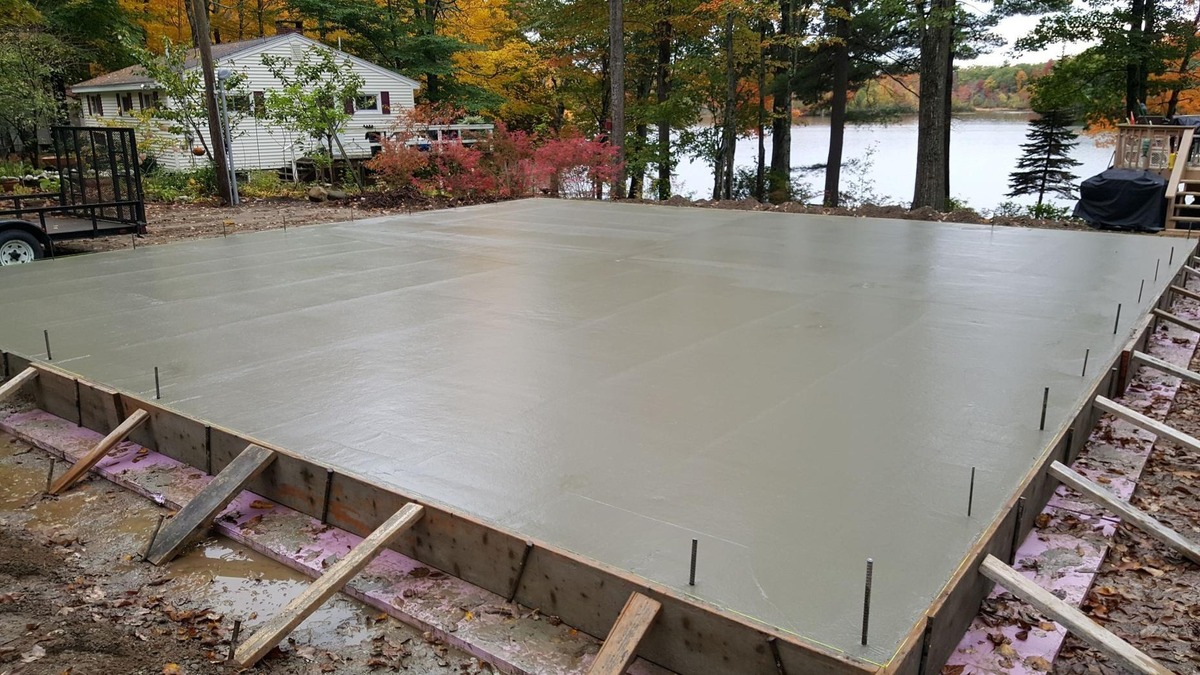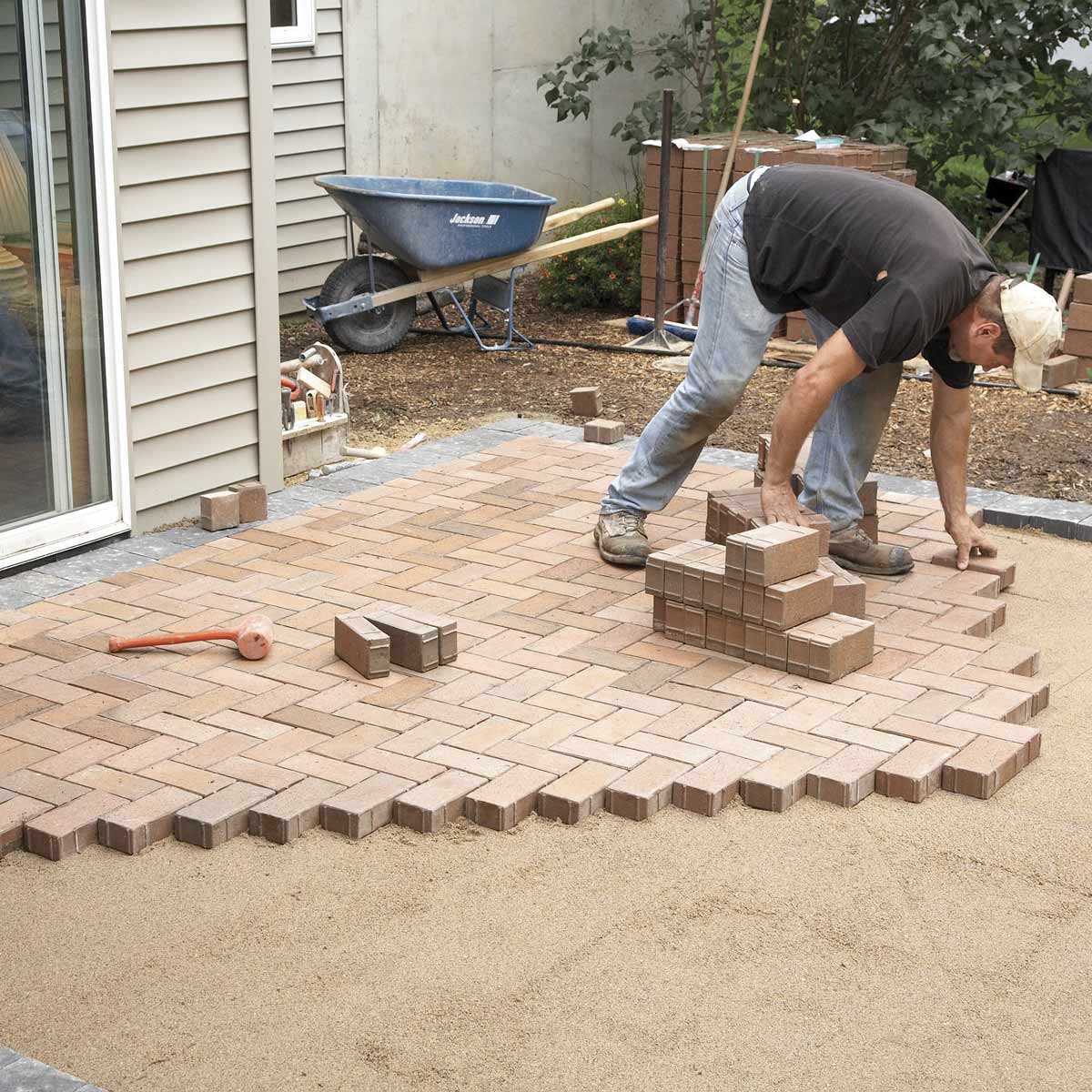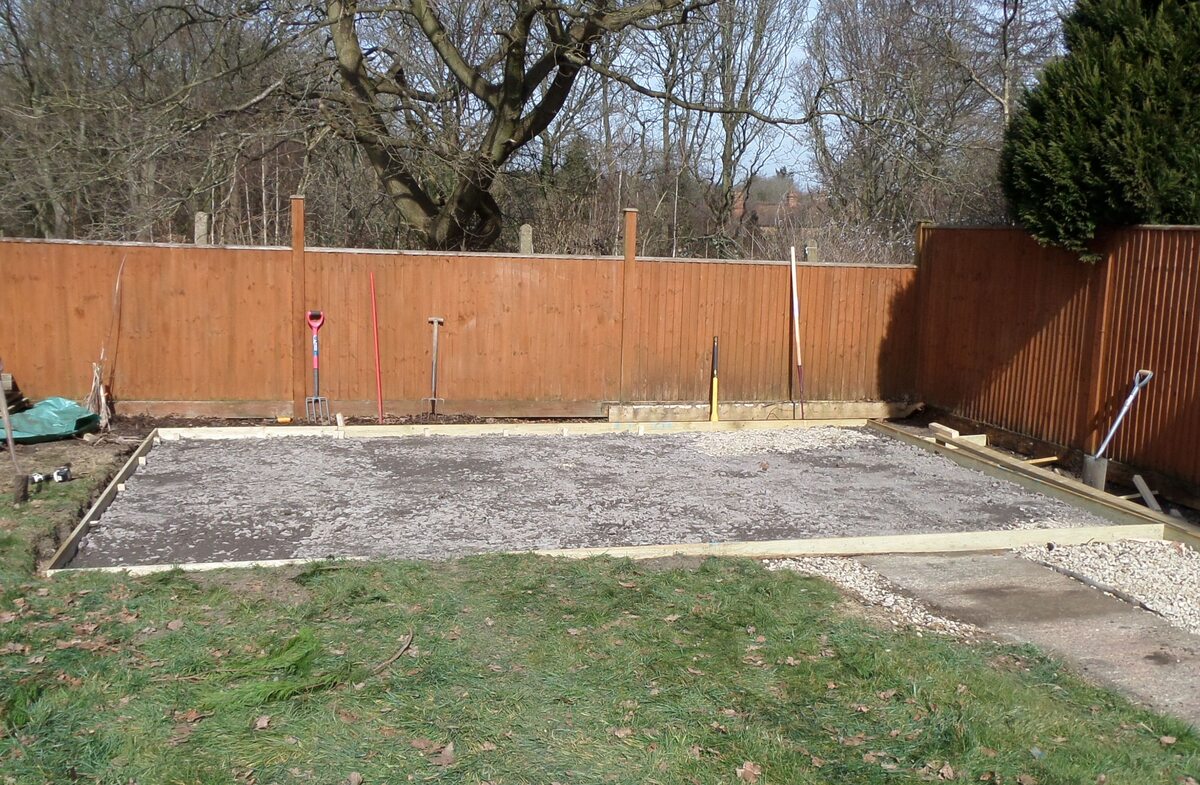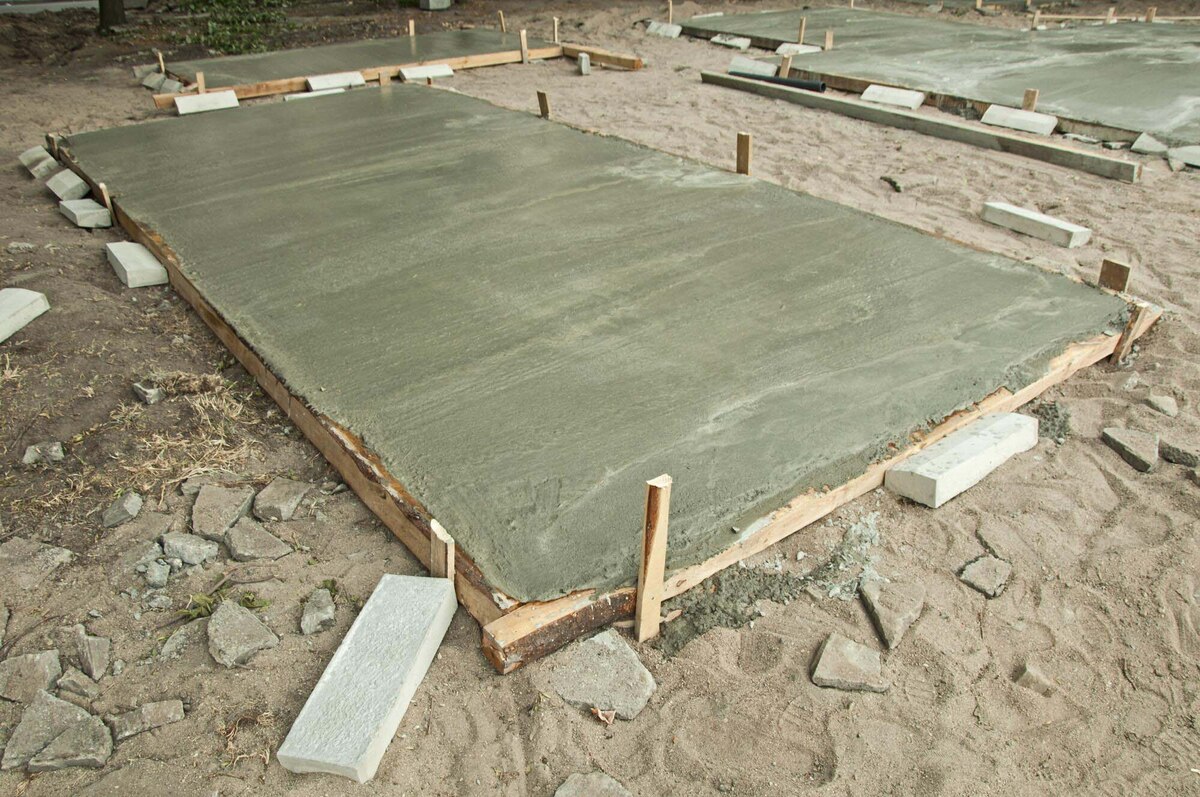Home>Furniture>Outdoor Furniture>How Thick Should A Concrete Patio Slab Be


Outdoor Furniture
How Thick Should A Concrete Patio Slab Be
Modified: October 29, 2024
Ensure the durability of your outdoor furniture by determining the ideal thickness for your concrete patio slab. Find out how thick it should be for long-lasting support.
(Many of the links in this article redirect to a specific reviewed product. Your purchase of these products through affiliate links helps to generate commission for Storables.com, at no extra cost. Learn more)
Introduction
Welcome to the world of outdoor living! If you are considering adding a patio to your home, one of the key factors to consider is the thickness of the concrete slab. The thickness of the slab is crucial as it determines the durability, stability, and longevity of your patio.
But how thick should a concrete patio slab be? The answer to this question depends on several factors, including the climate and soil conditions in your area, as well as the desired use of your patio. In this article, we will explore these factors and provide recommendations for the optimal thickness of a standard concrete patio slab. We will also discuss reinforcement options for thicker patio slabs, as well as the tools and materials you will need to pour and finish your patio.
So, let’s dive in and learn more about the factors that influence the thickness of a concrete patio slab!
Key Takeaways:
- Consider climate, soil, and usage when determining concrete patio slab thickness. Thicker slabs are needed for freeze-thaw cycles, expansive soil, and heavy loads.
- Properly pour, finish, cure, and maintain your concrete patio slab for durability and longevity. Seek professional assistance if unsure.
Read more: How Thick Of A Concrete Slab For A Hot Tub
Factors to consider when determining the thickness of a patio slab
When it comes to determining the thickness of a patio slab, there are several important factors to consider. These factors will help ensure that your patio is built to withstand the test of time and provide a stable surface for all your outdoor activities. Let’s take a closer look at these factors:
- Climate: The climate in your area plays a significant role in determining the thickness of your patio slab. Regions with freeze-thaw cycles, where the ground freezes in winter and thaws in spring, require a thicker slab to prevent cracking and shifting. On the other hand, milder climates may not require as thick of a slab.
- Soil Conditions: The type of soil in your yard can also impact the thickness of the patio slab. Clay soil, which expands and contracts with moisture changes, requires a thicker slab to prevent cracking. Sandy or loamy soil, which is more stable, may allow for a thinner slab.
- Use of the Patio: How you plan to use the patio will also influence the thickness of the slab. If you intend to park heavy vehicles or equipment on the patio, a thicker slab will be needed to withstand the weight. For a patio that will primarily be used for entertaining or relaxation, a slightly thinner slab may suffice.
- Building Codes: It is important to consult your local building codes and regulations when determining the thickness of the patio slab. Different areas may have specific requirements regarding minimum thickness and reinforcement for outdoor concrete structures.
By considering these factors, you can determine the appropriate thickness for your patio slab and ensure its long-term durability. Keep in mind that it is always better to err on the side of caution and opt for a slightly thicker slab if you are unsure.
Climate and soil conditions
When it comes to building a patio, understanding the climate and soil conditions in your area is essential for determining the appropriate thickness of the concrete slab. Let’s take a closer look at how these factors influence the patio slab thickness:
Climate: The climate in your region can have a significant impact on the durability and stability of your patio slab. In areas with freezing temperatures, the ground tends to expand when it freezes and contract when it thaws. This movement can exert pressure on the patio slab, leading to cracks and unevenness. To counter these effects, a thicker concrete slab is recommended. Typically, a minimum thickness of 4 inches (10 cm) is recommended for regions with freeze-thaw cycles.
Soil Conditions: The type of soil in your yard also plays a crucial role in determining the thickness of the patio slab. Clay and expansive soils have a tendency to shrink and swell with changes in moisture content. This movement can cause the patio slab to crack or shift. In areas with clay or expansive soil, a thicker slab is required to distribute the weight more evenly and provide stability. On the other hand, if your yard has sandy or well-compacted soil, a slightly thinner slab may be suitable.
It is important to note that even in areas with stable soil conditions, a minimum thickness of 4 inches (10 cm) for a patio slab is generally recommended. This thickness provides adequate strength and durability to support the weight of furniture, foot traffic, and outdoor activities.
Keep in mind that local building codes and regulations may have specific requirements regarding the thickness of a patio slab based on climate and soil conditions. Therefore, it is crucial to consult with local authorities or a professional contractor to ensure compliance with these guidelines.
By considering the climate and soil conditions in your area, you can determine the optimal thickness for your patio slab. This will not only ensure the stability and durability of your patio but also prevent costly repairs in the future.
Recommended thickness for standard concrete patio slabs
When it comes to the thickness of a standard concrete patio slab, there are some general guidelines that can help you determine the appropriate thickness for your project. The recommended thickness will depend on several factors, including the intended use of the patio and the load it will need to bear. Here are some typical recommendations:
- Residential Patios: For most residential patio applications, a thickness of 4 inches (10 cm) is considered standard. This thickness can handle normal foot traffic, patio furniture, and moderate outdoor activities. It provides a reliable and durable surface for everyday use.
- Vehicle Traffic: If you plan to park vehicles or heavy equipment on your patio, you will need to increase the slab thickness to accommodate the additional load. A thickness of 6 inches (15 cm) or more is recommended for areas that will experience vehicular traffic. This extra thickness ensures that the slab can withstand the weight without cracking or shifting.
- Commercial or High-Traffic Areas: In commercial settings or areas with high foot traffic, it is advisable to use a thicker slab to withstand the constant wear and tear. A thickness of 6 inches (15 cm) or more is often recommended for these situations. Reinforcement options, such as steel mesh or rebar, may also be necessary to enhance the strength and stability of the slab.
It is important to note that these recommendations are general guidelines and may need to be adjusted based on your specific project requirements and local building codes. Consulting with a professional contractor or engineer can provide valuable insights and ensure that you choose the appropriate thickness for your standard concrete patio slab.
Remember, investing in a thicker patio slab not only provides immediate strength and durability but also adds peace of mind knowing that your outdoor space can withstand the test of time and regular use.
Reinforcement options for thicker patio slabs
When you’re dealing with thicker patio slabs, especially those that will be subjected to heavy loads or high traffic, additional reinforcement can enhance their strength and durability. Reinforcement options help distribute the load more evenly and minimize the risk of cracking or shifting. Here are some commonly used reinforcement options for thicker patio slabs:
- Steel Mesh: Steel mesh is a commonly used reinforcement option for thicker patio slabs. It consists of a grid of interconnected steel wires that are placed in the middle of the concrete slab during the pouring process. The steel mesh helps to reinforce the slab and distribute the load, improving its tensile strength and resistance to cracking.
- Rebar: Rebar, short for reinforcing bar, is another popular reinforcement option for thicker patio slabs. It involves placing steel bars or rods within the concrete at specific intervals and securing them with ties or wire mesh. Rebar provides increased strength and stability to the slab, making it suitable for heavy load-bearing applications or areas with expansive soil conditions.
- Fiber Reinforcement: Fiber reinforcement is a newer option that involves adding small fibers, such as synthetic or steel fibers, to the concrete mix. These fibers help to improve the overall strength and crack resistance of the slab. Fiber reinforcement is often used in combination with other reinforcement methods for optimal results.
It is important to note that the choice of reinforcement option will depend on various factors, including the expected load, soil conditions, and local building codes. Consulting with a professional contractor or engineer is recommended to determine the most suitable reinforcement option for your specific patio project.
Remember, while reinforcement can greatly enhance the strength and durability of thicker patio slabs, it is essential to ensure proper installation and placement of the reinforcement material. This will ensure that the reinforcement is effectively integrated into the concrete and provides the desired benefits.
By considering appropriate reinforcement options, you can create patio slabs that are capable of withstanding heavy loads, high traffic, and challenging soil conditions, ensuring the longevity and structural integrity of your outdoor living space.
A concrete patio slab should be at least 4 inches thick for residential use. However, if it will be supporting heavy loads or vehicles, it should be 6-8 inches thick. Always consult a professional for specific project requirements.
Read more: How Thick Should A Slab Be For A Shed
Tools and materials required for pouring a concrete patio slab
Pouring a concrete patio slab requires careful planning and the right tools and materials to ensure a successful and long-lasting result. Whether you are hiring a professional or tackling the project yourself, here are the essential tools and materials you will need:
Tools:
- Shovel: A sturdy shovel is essential for excavating the area where the patio will be installed and removing any grass, rocks, or debris.
- Tape measure and level: These tools will help you measure and ensure that the patio is level and properly aligned.
- Wheelbarrow or mixing tub: You will need a wheelbarrow or a large mixing tub to mix the concrete.
- Concrete mixer (optional): If you are working on a larger project and need to mix a significant amount of concrete, using a concrete mixer can be more efficient.
- Concrete edger and trowels: These tools are used to smooth and finish the surface of the concrete once it is poured. They help create a professional and polished appearance.
- Concrete float: A concrete float is used to level and smooth the surface of the concrete while it is still wet. It ensures an even and uniform finish.
- Broom or brush: After the concrete has been floated, a broom or brush can be used to create a textured finish on the surface for better grip and to prevent slipping.
- Finishing sealer (optional): Applying a finishing sealer to the cured concrete surface can help protect it from stains, moisture, and UV damage.
Materials:
- Concrete mix: Choose a high-quality concrete mix specifically designed for outdoor applications. The amount of concrete mix you will need depends on the size and thickness of your patio slab.
- Gravel or crushed stone: A layer of gravel or crushed stone is usually placed as a base for the patio slab. It helps with drainage and provides stability.
- Reinforcement material: Depending on the thickness and load requirements of your patio slab, you may need steel mesh, rebar, or fiber reinforcement material. Consult with a professional to determine the appropriate reinforcement option.
- Plastic sheeting or curing compound: To prevent the concrete from drying too quickly and to promote proper curing, you may need to cover the patio slab with plastic sheeting or use a curing compound.
Before starting your project, make sure to gather all the necessary tools and materials. It is also important to follow proper safety precautions, wear protective gear, and work in well-ventilated areas when handling and pouring concrete.
With the right tools and materials, you will be well-equipped to successfully pour and create a beautiful and durable concrete patio slab.
Steps to pour and finish a concrete patio slab
Pouring and finishing a concrete patio slab requires careful planning and attention to detail. Follow these steps to ensure a successful installation:
- Prepare the area: Start by clearing the area where the patio will be poured. Remove any grass, rocks, or debris, and ensure the ground is level.
- Install forms: Create forms around the perimeter of the patio using wooden boards or metal stakes. Make sure the forms are level and secure.
- Add gravel base: Add a layer of gravel or crushed stone as a base for the patio slab. This will improve drainage and provide stability.
- Mix the concrete: Follow the instructions on the concrete mix bag to prepare the concrete. Mix it thoroughly in a wheelbarrow or mixing tub, or use a concrete mixer if you have a larger project.
- Pour the concrete: Pour the mixed concrete into the forms, starting from one end and working your way to the other. Fill the forms evenly to achieve a consistent thickness throughout the slab.
- Smooth and level the surface: Use a concrete float to smooth and level the surface of the concrete while it is still wet. Work the float in a back-and-forth motion to eliminate any bumps or unevenness.
- Create a textured finish: After floating, use a broom or brush to create a textured finish on the surface. This will help improve traction and prevent slipping.
- Cure the concrete: Cover the patio slab with plastic sheeting or use a curing compound to ensure proper curing. This will prevent the concrete from drying too quickly and help it attain maximum strength.
- Remove forms: Once the concrete has cured for the recommended time (typically 24-48 hours), carefully remove the forms from around the patio slab. Use a pry bar or hammer to gently release the forms.
- Apply finishing sealer (optional): If desired, apply a finishing sealer to the cured concrete surface. This will help protect it from stains, moisture, and UV damage, and enhance its appearance.
Remember to follow proper safety precautions throughout the entire process, wear protective gear, and work in a well-ventilated area. It is also important to consult local building codes and regulations, as they may have specific requirements for pouring and finishing concrete patio slabs.
With patience and attention to detail, you can create a beautiful and functional concrete patio slab that will provide years of enjoyment for outdoor activities and relaxation.
Curing and maintenance of a newly poured concrete patio slab
Proper curing and maintenance are crucial for ensuring the longevity and durability of a newly poured concrete patio slab. Curing refers to the process of allowing the concrete to properly hydrate and strengthen, while maintenance involves taking care of the slab to prevent damage. Follow these guidelines to effectively cure and maintain your concrete patio:
Curing:
- Keep the concrete moist: After pouring the patio slab, it is important to keep the concrete moist to promote proper curing. Cover the slab with plastic sheeting or use a curing compound to prevent moisture loss. This helps the concrete develop its maximum strength.
- Avoid rapid drying: To prevent rapid drying, avoid exposing the patio slab to direct sunlight or hot weather conditions during the curing process. Shield the slab from extreme temperatures and wind, as they can cause rapid moisture evaporation and lead to cracking.
- Monitor for proper hydration: Check the concrete periodically during the curing process to ensure that it remains sufficiently moist. If the concrete appears to be drying out, lightly mist it with water or reapply the plastic sheeting to maintain the desired moisture level.
- Allow adequate curing time: The curing time for a concrete patio slab can vary depending on factors such as weather conditions and the concrete mix used. Generally, a minimum curing time of 7 to 14 days is recommended before subjecting the patio to heavy use or placing furniture on it. However, consult the manufacturer’s guidelines and local building codes for specific recommendations.
Maintenance:
- Keep the patio clean: Regularly sweep or rinse off dirt, leaves, and debris from the patio surface to prevent staining and minimize the risk of slips or falls. Avoid using harsh chemicals or abrasive cleaners that can damage the concrete.
- Address spills promptly: Clean up any spills, such as oil or grease, as soon as possible to prevent staining. Use an absorbent material, like kitty litter or sawdust, to soak up the spill, and then clean the area with a mild detergent and water.
- Protect the patio from heavy impacts: Avoid dropping heavy objects or dragging sharp items across the patio surface, as this can cause cracks or damage the concrete. Place furniture glides or pads under the legs of outdoor furniture to prevent scratching or indentation.
- Apply sealer periodically: Applying a protective sealer every few years can help enhance the longevity and appearance of your concrete patio slab. The sealer helps to repel water, prevent stains, and resist UV damage. Follow the manufacturer’s instructions for proper application.
- Monitor for signs of damage: Regularly inspect the patio slab for any signs of cracks, spalling, or settlement. If you notice any damage, consult a professional to assess the issue and recommend appropriate repairs.
By following these curing and maintenance guidelines, you can ensure that your newly poured concrete patio slab remains in excellent condition, withstands the test of time, and provides a beautiful outdoor space for years to come.
Conclusion
Adding a concrete patio to your outdoor space can greatly enhance its functionality and aesthetic appeal. When determining the thickness of a patio slab, it is important to consider various factors such as climate, soil conditions, and the intended use of the patio. By understanding these factors, you can make informed decisions to ensure the durability and longevity of your patio.
For standard concrete patio slabs, a thickness of 4 inches (10 cm) is generally recommended for residential use. However, if you anticipate heavier loads or vehicular traffic, a thickness of 6 inches (15 cm) or more may be necessary. Reinforcement options such as steel mesh, rebar, or fiber reinforcement can further enhance the strength of thicker patio slabs.
When pouring and finishing a concrete patio slab, it is essential to follow proper techniques and use the right tools and materials. This includes preparing the area, pouring the concrete evenly, and finishing the surface to achieve a polished and professional look.
After pouring a patio slab, proper curing and maintenance are key to its long-term performance. Curing involves keeping the concrete moist and protected from rapid drying, while maintenance includes regular cleaning, prompt spill cleanup, and periodic application of a protective sealer.
By considering these guidelines and taking the necessary steps to determine the appropriate thickness, properly pour and finish the concrete, and maintain the patio slab, you can enjoy a beautiful, durable, and functional outdoor living space for years to come.
Remember, if you are unsure or inexperienced in pouring concrete, it is always recommended to seek the assistance of a professional contractor who can ensure the job is done correctly and efficiently.
Now, go ahead and create the perfect outdoor space with a well-designed and professionally constructed concrete patio slab!
Once you've laid down your perfect patio slab, why not spruce up the surroundings to match? Dive into our guide on vibrant deck decor and straightforward enhancements that transform any outdoor space into a haven for relaxation and entertainment. Ready for more? Discover inspiring and practical garden fence ideas that not only increase privacy but also boost your home's curb appeal. Both guides offer invaluable tips to elevate your exterior spaces effortlessly.
Frequently Asked Questions about How Thick Should A Concrete Patio Slab Be
Was this page helpful?
At Storables.com, we guarantee accurate and reliable information. Our content, validated by Expert Board Contributors, is crafted following stringent Editorial Policies. We're committed to providing you with well-researched, expert-backed insights for all your informational needs.















0 thoughts on “How Thick Should A Concrete Patio Slab Be”